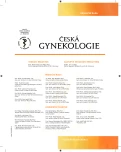-
Medical journals
- Career
A recommended interdisciplinary guideline the diagnosis and treatment of sepsis during pregnancy
Authors: V. Adámková 1; M. Balík 2; J. Bláha 2; V. Černý 3; M. Kolář 4; J. Mašata 5; J. Melichar 5; A. Pařízek 5; R. Pilka 6; R. Plavka 5; P. Štourač 7
Authors‘ workplace: Ústav lékařské biochemie a laboratorní diagnostiky, Klinická mikrobiologie a ATB centrum, 1. LF UK a VFN, Praha 1; Klinika anesteziologie, resuscitace a intenzivní medicíny 1. LF UK a VFN, Praha 2; Klinika anesteziologie, perioperační a intenzivní medicíny Univerzity J. E. Purkyně a Masarykovy nemocnice, Ústí nad LabemDept. of Anesthesia, Pain Management and Perioperative Medicine, Dalhousie University, Halifax, Canada, Klinika anesteziologie, resus 3; Ústav mikrobiologie LF UP a FN, Olomouc 4; Gynekologicko-porodnická klinika 1. LF UK a VFN, Praha 5; Gynekologicko-porodnická klinika LF UP a FN, Olomouc 6; Klinika dětské anesteziologie a resuscitace, Masarykovy univerzity a FN, Brno 7
Published in: Ceska Gynekol 2016; 81(2): 134-139
Overview
Sepsis during pregnancy is a serious cause of maternal mortality. Severe sepsis with acute organ failure is the cause of around 15–30% of in-hospital mortality, and if septic shock develops than maternal mortality can reach about 40%. The goal of this new recommended procedure is a guide for the organized care of pregnant women with signs of sepsis. Any significant changes in the health status and/or basic physiological functions of pregnant women that are unexplained by other causes should be considered to be signs of the possible development of sepsis until this is ruled out. Pregnant women with possible sepsis should be transferred to a department where their basic physiological functions can be monitored. An intravenous infusion of an adequate anti-infectious therapy (antibiotics) should be started as soon as possible, no later than within an hour of identifying severe sepsis. As part of organizational arrangements it is recommended to draw up a formalized protocol for the timely identification of pregnant women with signs of sepsis, and to define a process for treatment after activation of a system for early warnings at specific workstations. It is also important to introduce a rapid response system (RRS), which can be activated through the suspicions of even intermediate-level medical personnel. The goal of such a system is to ensure the start of treatment without delay. Such delays in the start of treatment procedures worsen clinical outcomes exponentially.
Keywords:
guidelines, pregnancy, infection, sepsis, severe sepsis, septic shock
Sources
1. Acosta, CD., Kurinczuk, JJ., Lucas, DN., et al. United Kingdom Obstetric Surveillance System. Severe maternal sepsis in the UK, 2011-2012: a national case-control study. PLoS Med, 2014, 11(7).
2. Barton, JR., Sibai, BM. Severe sepsis and septic shock in pregnancy. Obstet Gynecol, 2012, 120(3), p. 689–706.
3. Maguire, PJ., O‘Higgins, AC., Power, KA., et al. Maternal bacteremia and the Irish maternity early warning system. Int J Gynaecol Obstet, 2015, 129(2), p. 142–145.
4. Morgan, J., Roberts, S. Maternal sepsis. Obstet Gynecol Clin North Am, 2013, 40, p. 69.
5. Royal College of Obstetricians and Gynaecologists – Bacterial Sepsis in Pregnancy, April 2012, [on/line], dostupné z: https://www.rcog.org.uk/en/guidelines-research-services/guidelines/gtg64a/
6. www.survivingsepsis.org
Labels
Paediatric gynaecology Gynaecology and obstetrics Reproduction medicine
Article was published inCzech Gynaecology

2016 Issue 2-
All articles in this issue
- Czech Hospital in Uganda and quality of obstetric care
- Posterm pregnancy
- Induction of labor
- Current status and recommendations for intrapartum monitoring of fetal heart rate
- Delivery of macrosomic fetus
- Assisted vaginal delivery
- A recommended interdisciplinary guideline the diagnosis and treatment of sepsis during pregnancy
- Use of methotrexate in the ectopic pregnancy and pregnancy of unknown location
- Diagnosis of tuberous sclerosis complex focusing on prenatal period
- Czech Gynaecology
- Journal archive
- Current issue
- Online only
- About the journal
Most read in this issue- Current status and recommendations for intrapartum monitoring of fetal heart rate
- Induction of labor
- Posterm pregnancy
- Delivery of macrosomic fetus
Login#ADS_BOTTOM_SCRIPTS#Forgotten passwordEnter the email address that you registered with. We will send you instructions on how to set a new password.
- Career

